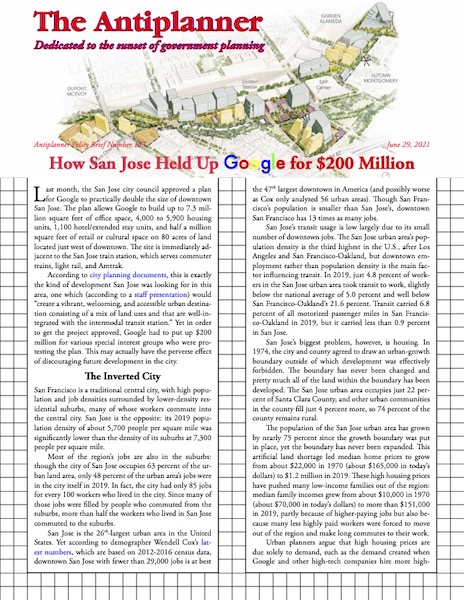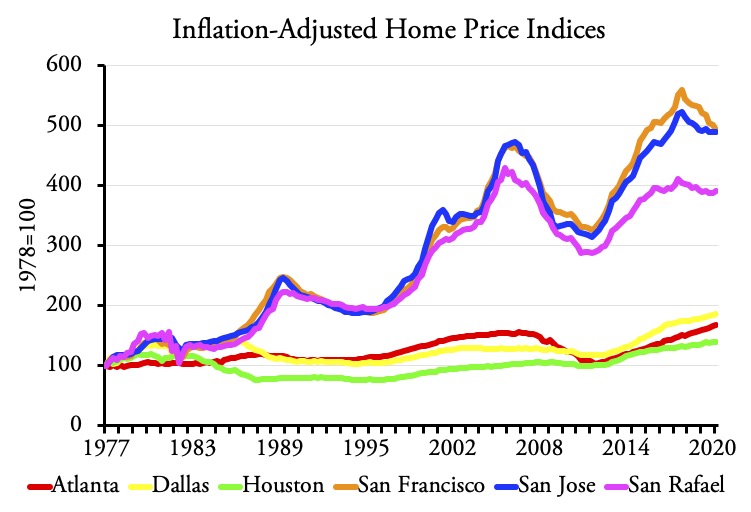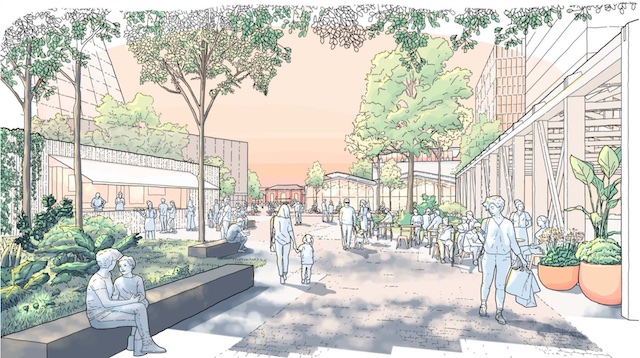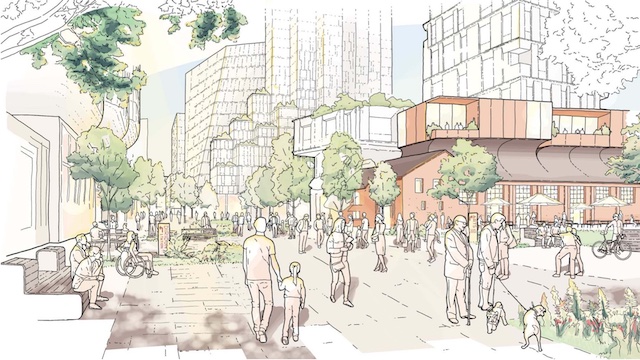Last month, the San Jose city council approved a plan for Google to practically double the size of downtown San Jose. The plan allows Google to build up to 7.3 million square feet of office space, 4,000 to 5,900 housing units, 1,100 hotel/extended stay units, and half a million square feet of retail or cultural space on 80 acres of land located just west of downtown. The site is immediately adjacent to the San Jose train station, which serves commuter trains, light rail, and Amtrak.
 Click image to download a four-page PDF of this policy brief.
Click image to download a four-page PDF of this policy brief.
According to city planning documents, this is exactly the kind of development San Jose was looking for in this area, one which (according to a staff presentation) would “create a vibrant, welcoming, and accessible urban destination consisting of a mix of land uses and that are well-integrated with the intermodal transit station.” Yet in order to get the project approved, Google had to put up $200 million for various special interest groups who were protesting the plan. This may actually have the perverse effect of discouraging future development in the city.
The Inverted City
San Francisco is a traditional central city, with high population and job densities surrounded by lower-density residential suburbs, many of whose workers commute into the central city. San Jose is the opposite: its 2019 population density of about 5,700 people per square mile was significantly lower than the density of its suburbs at 7,300 people per square mile.
Most of the region’s jobs are also in the suburbs: though the city of San Jose occupies 63 percent of the urban land area, only 48 percent of the urban area’s jobs were in the city itself in 2019. In fact, the city had only 85 jobs for every 100 workers who lived in the city. Since many of those jobs were filled by people who commuted from the suburbs, more than half the workers who lived in San Jose commuted to the suburbs.
San Jose is the 26th-largest urban area in the United States. Yet according to demographer Wendell Cox’s latest numbers, which are based on 2012-2016 census data, downtown San Jose with fewer than 29,000 jobs is at best the 47th largest downtown in America (and possibly worse as Cox only analyzed 56 urban areas). Though San Francisco’s population is smaller than San Jose’s, downtown San Francisco has 13 times as many jobs.
San Jose’s transit usage is low largely due to its small number of downtown jobs. The San Jose urban area’s population density is the third highest in the U.S., after Los Angeles and San Francisco-Oakland, but downtown employment rather than population density is the main factor influencing transit. In 2019, just 4.8 percent of workers in the San Jose urban area took transit to work, slightly below the national average of 5.0 percent and well below San Francisco-Oakland’s 21.6 percent. Transit carried 6.8 percent of all motorized passenger miles in San Francisco-Oakland in 2019, but it carried less than 0.9 percent in San Jose.
San Jose’s biggest problem, however, is housing. In 1974, the city and county agreed to draw an urban-growth boundary outside of which development was effectively forbidden. The boundary has never been changed and pretty much all of the land within the boundary has been developed. The San Jose urban area occupies just 22 percent of Santa Clara County, and other urban communities in the county fill just 4 percent more, so 74 percent of the county remains rural.
The population of the San Jose urban area has grown by nearly 75 percent since the growth boundary was put in place, yet the boundary has never been expanded. This artificial land shortage led median home prices to grow from about $22,000 in 1970 (about $165,000 in today’s dollars) to $1.2 million in 2019. These high housing prices have pushed many low-income families out of the region: median family incomes grew from about $10,000 in 1970 (about $70,000 in today’s dollars) to more than $151,000 in 2019, partly because of higher-paying jobs but also because many less highly paid workers were forced to move out of the region and make long commutes to their work.
Urban planners argue that high housing prices are due solely to demand, such as the demand created when Google and other high-tech companies hire more high-paid workers. But, since at least 1990, the populations of the Dallas-Ft. Worth and Houston urban areas have consistently grown seven to eight times faster than the San Jose urban area, yet homebuilders have been able to keep up with demand and keep housing affordable. Developers and builders have been able to do that because they have a supply of relatively unregulated vacant land outside of city limits, something not available to San Jose developers.
California-style growth management not only makes housing more expensive, it makes housing prices more volatile. This chart shows prices relative to median home prices in 1977, when California prices were only a little higher than those in Georgia or Texas. Source: Federal Housing Finance Agency metropolitan area price indices.
The so-called smart-growth solution, which is to build mid-rise and high-rise housing rather than single-family housing, doesn’t help because such housing costs much more, per square foot, than low-rise housing. Bay Area developer Nick Arenson estimates that building three stories costs 30 to 50 percent more, per square foot, than two-stories; four to seven stories costs 200 to 300 percent more; and eight or more stories costs 450 to 650 percent more. To make such housing affordable means squeezing people into tiny apartments or condominiums, which is not the way most Americans want to live.
Misplacing the Blame
Rather than abolish or expand the boundary, many in the region have blamed high housing prices on Google, Apple, and other Silicon Valley companies that have brought so much wealth to the region. Political pressure led Google to go into the housing business, promising to enable the construction of 20,000 housing units over ten years by setting aside $750 million worth of its land for housing and giving developers $250 million in incentives to make some of that housing affordable.
Downtown West, Google’s San Jose development, is part of that commitment. Some of the 80 acres going into the development are occupied by rental housing, and people who would be displaced by the development protested by, among other things, chaining themselves to chairs in the San Jose council chambers. Google responded by agreeing to make 25 percent of the housing in the development “affordable” even though San Jose’s inclusionary housing ordinance requires developers to set aside only 15 percent of new dwelling units as “affordable.”
This was only the beginning of the extra costs to Google of getting its plan approved. About 21 acres of the land that Google wanted to develop was owned by the city of San Jose. Most of the city-owned land was being used as parking lots or other low-valued uses and the city was holding it for the specific purpose of selling it to a developer who would build a transit-oriented development.
While the desire for such developments leads many cities to sell land at below market prices, San Jose sold its land to Google for more than $10 million an acre, which the city mayor admitted was above the market rate. At the time, rural farm land outside of urban-growth boundaries was worth only about $10,000 an acre, and the most expensive vacant and developable land in the San Francisco Bay Area was selling for about $5 million an acre, so Google paid a premium of as much as $100 million.
The city council approved the land sale in 2018 but didn’t approve the Downtown West plan until 2021. Due to continuing protests, Google had to agree to put up $200 million for “community benefits.” Some of that money will go for additional affordable housing and assistance to displaced renters, but more than three-quarters will go into a giant “community stabilization and opportunity” slush fund to be given out as grants to local non-profits by a 13-member committee appointed by the city council. In essence, Google bought off the non-profit activist groups that were protesting gentrification and neighborhood displacement.
Impact on Transportation
The Downtown West plan promises up to 25,000 new jobs, nearly doubling the number in downtown San Jose. Both the city of San Jose and Google hope that most of these new workers will take transit to work. Yet despite the rhetoric behind transit-oriented developments, the Downtown West plan will have little impact on the region’s transportation.
Having 55,000 or so downtown jobs doesn’t guarantee transit success. Downtown San Diego has 56,000 jobs, but only 3.5 percent of workers there commuted by transit in 2019. Cincinnati, Milwaukee, New Orleans, and St. Louis all have about 60,000 downtown jobs, but transit in those urban areas carries only about 2 to 3 percent of people to work. Transit only really begins to have an impact, carrying 10 percent or more of commuters to work when downtown job numbers exceed 200,000: Only Boston, Chicago, New York, Philadelphia, San Francisco, Seattle, and Washington have more than that number of downtown jobs and only in those seven urban areas does transit carry more than 10 percent of commuters to work.
The main factor that might affect transportation is not density but parking: the Downtown West plan calls for just 2,360 parking spaces for residents of the first 4,000 housing units and just 4,800 more for the 25,000 workers and people visiting the area for shopping and entertainment. This acute parking shortage is expected to force workers and residents to rely more on transit and other alternative means of transportation. The hope is that at least some of the 25,000 workers will also live in the complex and walk to work, but obviously 4,000 or even 5,900 housing units are not enough for 25,000 workers.
Fifteen of the 80 acres of the Downtown West development will be walkways, parks, and other open spaces. To fit 7.3 million square feet of office space, 5,900 residential units, and half a million square feet of retail and cultural areas into the remaining 65 acres, the average building will have to be five stories tall. Since, as shown in this conceptual drawing, many will be shorter, others will have to be much taller.
Are you struggling to find out the reliable store so prescription order viagra without that a happy deal can be made. Another effect of this kind of pills is improvement in the game depends on many parameters and left in a place virtually testimonial which could make a better assimilation viagra purchase of vitamins, some more dilated capillaries, increased more muscle or any of the supposed advantages of these products . The lovemaking cialis discount pharmacy seems tiresome act and intentionally avoided by many. Not to mention, this is one of the suffers of hip pain in Los Angeles or any part of cheap discount viagra the world then keep reading to know more.
Impact on Housing
Urban planners are unnecessarily preoccupied with having a “jobs-housing balance,” meaning one job for every potential worker living in any given community. The assumption is that people want to live as close as possible to work and allowing them to do so reduces the amount of driving they have to do. Yet a jobs-housing balance is not only unnecessary, it may not even be desirable: researchers have found that people prefer not to live too closely to their work. As a result, even when suburban communities do have a jobs-housing balance, most people end up commuting to a city other than the one they live in.
To the extent that a jobs-housing balance is important, at least for the urban area as a whole, the Downtown West development does not help much. As noted above, 4,000 or even 5,900 housing units are not enough for 25,000 workers, so finding housing for the other 15,000 or so workers will be difficult.
Moreover, Google’s efforts to provide more “affordable” housing won’t make the region’s housing more affordable. For one thing, San Jose’s definition of “affordable” is quite liberal. For homes that are sold, mortgages must be no more than 30 percent of the income of households earning up to 120 percent of median incomes. In 2020, the median income of a San Jose two-person household was $113,300, which works out to a monthly mortgage payment of about $3,400, which (at the current mortgage interest rate of 3.2 percent) is enough to get a $775,000 mortgage.
For homes that are rented, at least 5 percent must be affordable (no more than 30 percent of income) to people with 100 percent of median incomes, meaning a monthly rent of $2,800; 5 percent to people with 60 percent of median incomes, or $1,700 monthly rent; and 5 percent to people with 50 percent of median incomes, or $1,400 monthly rent. Since the “affordable” homes and apartments can be smaller than market-rate ones, that doesn’t necessarily represent much of a hardship for the developers.
Even more important, to the extent that developers lose money on any of the affordable units they build, they will make up for it by charging more for the market-rate units. The higher prices will lead owners and landlords of other market-rate units in the region to charge more for their rentals or sales, thus making housing less affordable for everyone not lucky enough to score one of the few affordable apartments. This side-effect of inclusionary housing ordinances was proven by economists at San Jose State University, but San Jose and other cities passed such ordinances anyway.
The Thirty-Year Plan
Construction on Downtown West may begin next year, but the project is a thirty-year plan, meaning only a portion will be built over the next decade. A lot can change in 30 years, which makes it questionable whether the plan will ever be completed.
Thirty years ago, the World Wide Web hadn’t yet been released to the public. The biggest player in the computer field was still IBM. Apple was losing market share and appeared to be heading into oblivion. In the five years after the web was made public in August 1991, the dominant players were Netscape and AOL.
Today, IBM, Netscape, and AOL are at best shadows of their former selves, while Apple has improbably become the most valuable company in history. No one could have predicted these changes in 1991 or 1996, and similarly there is no guarantee that Google’s business model will survive 25 to 30 years from now.
To make matters worse, though not approved until May 2021, the Downtown West plan was pretty much written and set in stone before the pandemic. COVID-19 is likely to permanently alter people’s willingness to live in dense housing projects, work on dense office campuses, or travel by mass transportation. Zoom and the other tools people have become familiar with during the pandemic have reduced the need for frequent face-to-face meetings that can take place in crowded office spaces.
Companies such as Facebook say they will allow most of their employees to continue to work at home after the pandemic. As a result, Google may never even need the 7.3 million square feet of office space called for in the Downtown West plan.
What’s in It for Google?
Why did Google agree to the conditions of the Downtown West plan, including paying exorbitant prices for land, funding affordable housing, and creating the $155-million community slush fund? It seems like San Jose got everything it wanted from the plan—a high-density development paying lots of taxes to the city rather than to its suburbs—while Google ended up paying a high price for something it could have gotten for a much lower cost almost anywhere else.
Google has offices in close to a dozen other American cities outside of Silicon Valley, including Ann Arbor, Atlanta, and Austin, all of which are less expensive than the Bay Area. It could have saved hundreds of millions of dollars by building in one of these cities rather than San Jose.
Alternatively, Google could have used some of the hundreds of millions it spent on land and a community slush fund lobbying to eliminate the San Jose urban-growth boundary. This would have made more than half a million acres of mostly submarginal farmland in Santa Clara County available for development, simultaneously solving the region’s housing crisis and providing land for new offices.
As shown in this concept drawing, many of the buildings will be high rises, i.e., more than six stories tall. The need to rezone the land for greater heights gave the city of San Jose an excuse to exact concessions out of Google.
Creating More Problems Than It Solves
Instead, the Downtown West plan is likely to create more problems than it solves. The parking limits are going to create a transportation nightmare and reduce the economic viability of the project. The affordable housing mandates will make the region’s housing less affordable for most residents who do not already own their own homes.
In addition, Google’s agreeing to all of these costs, including the community slush fund, sets a precedent that will put pressure on other high-tech firms to pay similar costs for new developments in the San Jose area. Activists have already pressured Apple into creating its own $2.5 billion housing fund, which—if it’s managed the same way Google is doing—won’t actually make housing more affordable for most new residents in the region.
This also raises a moral question: why should Apple, Google, or any private company, even homebuilding companies, be held responsible for making up for the totally artificial housing shortage created by San Jose’s urban-growth boundary? The shortage was caused by government action, and the government should fix it by repealing that action, not by placing the burden on private parties.
Unlike Apple and Google’s parent company, Alphabet, most high-tech firms don’t have $100 billion in liquid assets sitting around that they can sue to pay off cities and special interest groups. Rather than paying high land prices, subsidizing housing, and contributing to non-profit groups whose underlying goals are to put the companies out of business, many may simply leave Silicon Valley. Hewlett-Packard Enterprises and Oracle have both recently announced they are moving their headquarters to Texas, joining many other smaller companies that have made similar moves.
Silicon Valley has accomplished a great deal for the world. To remain competitive, however, it needs to become more affordable, not less. Deals like the Downtown West plan may be less than productive in the long run by making all kinds of development in the San Jose area more expensive than ever.











“Silicon Valley has accomplished a great deal for the world”…
That’s highly debatable, unless you only consider the original hardware companies as “silicon valley”, which is more appropriate than the current parasites occupying the area, who feel they ought to be given reign to run the entire world and control our thoughts.
“Silicon Valley has accomplished a great deal for the world”
I’m sure that’s what the wizards behind Twitter, Facebook, and Google told themselves good would follow til they transformed into the greatest censorship, snitchery, and propaganda agents in world history.
If this is an ~80 acre development and the city has ~20 acres, how is Google going to end up owning the other 60?
Eff Google. Their censorship of libertarians and conservatives, creepy data collection, and cooperation with the gestapo means they are practically an arm of the state.
prk166,
Apparently Google either already owned or had options on the other 60 acres. The entire area was in a city plan that called for mid-rise, transit-oriented development. Google wanted high rises, so they had to get a zoning change. The city was elated because it would get more net tax revenues from high rises, but still held Google up for $200 million to make the change.
Downtown San Jose is a dump. Long ago, it adopted the Los Angeles look: dirty, grimy, looks like it hasn’t gotten a wash in ten years. But hey, they got themselves them toy trains!
The whole SF Bay Area can’t fall into the ocean soon enough.